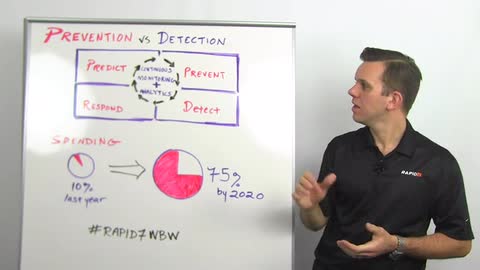
In this whiteboard Wednesday we will talk about the two major types of security products out there, preventative security products, and detection products.
Gartner states that security teams spend about 10% of their budget today on security products focused on detecting attackers within their network and they see that changing to 75% of their budget by the year 2020. As security teams come to realize that it is almost impossible to prevent every attack against their network and users, they will start to rebalance their security dollars to invest more heavily in incident detection and response.
If you are interested in learning how Rapid7 can help you detect and respond to attacks, check out our InsightIDR product or learn more about our incident response services.
Video Transcript
Hello and welcome to this Rapid7 Whiteboard Wednesday. My name is Chris Kirsch. I am the principal product marketing manager here at Rapid7 for userinsight (now InsightIDR). Today I would like to talk about the choice of prevention versus detection as part of your security program and how I think that's going to shift over the next few years. I'd like to borrow a graphic here from Gartner, a model of how they view security programs. Most companies start out with prediction. They start out with an asset inventory, with vulnerability management, maybe with penetration testing to check out where the systems are vulnerable. So this is just kind of trying to figure out and predicting where an attacker is most likely to get in. For example, the Nexpose vulnerability management solution would fit in the prediction category here.
Show more Show lessInsightIDR Product Demo
See how InsightIDR can help you detect intruders earlier in the attack chain.
Watch Demo